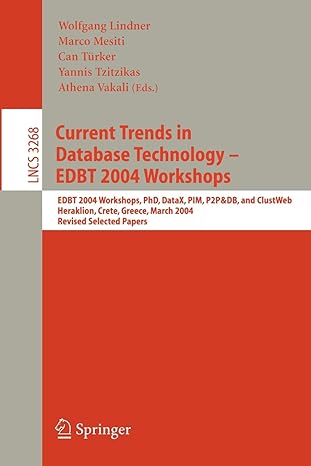Question
i want the program to be Writen in C++ and according to the step given below. Introduction CPU scheduling is a process of determining which
i want the program to be Writen in C++ and according to the step given below.
Introduction
CPU scheduling is a process of determining which processes run when there are multiple runnable processes. The goal of CPU scheduling is faster computation which is also fair and efficient
General Instructions
In this assignment, you will create a PCB (Process Control Block) class which holds the information of a process such as id, arrival time, start time, end time and burst time(job time). All possible class variables should be initialized in the constructor by reading the input file. Hence number of PCB objects is determined by the input file.
Create a Scheduler class. It should enqueue the PCB objects into a STL Queue based on the arrival time and dequeue a PCB object whenever the CPU is free. Calculate whether CPU is free based on the allocation time + burst time of the previous PCB object. Assume CPU is free for the initial case.
To Summarize the steps
1. Open input data source (Use of stringstream will bag you a bonus point)
2. Initialize clock (to zero)
3. Increment clock counter
4. Enqueue process (if any)
5. Check CPU availability. If available, dequeue one of the available process to the CPU based on the shortest burst time(job time)
6. If process in in CPU is done, free the CPU.
7. Repeat 3-6 till PCB queue and CPU are both empty
8. Print the following summary for each process.
i. Arrival Time (Time at which the process arrives in the ready queue.)
ii. Completion Time (Time at which process completes its execution)
iii. Burst Time(Time required by a process for CPU execution)
iv. Turn Around Time (Turn Around Time = Completion Time - Arrival Time + 1)
v. Waiting Time (Waiting Time = Turn Around Time - Burst Time)
Programming concepts that are expected in the solution:
The program should consist of at least 3 modules:
a) To create PCB
b) To implement Scheduler
c) To test the Scheduler
Following good object oriented programming practices
a) Keep the data members private
b)Accessor function should be declared to set and get the private data if needed.
Use operator << overloading to print the summary of PCB
Use appropriate STL container you should include a short paragraph justifying the use of the your chosen STL container a better choice will be awarded better grades!
Sample Input
ID Arrival Burst
| #1 | 1 | 8 |
|
| #2 | 3 | 2 |
|
| #3 | 4 | 6 |
|
| #4 | 8 | 2 |
|
| #5 | 12 | 1 |
|
Sample Output
At clock 0: CPU Available
PCB Queue (empty)
At clock 1: PCB #1 enqueued
PCB #1 dequeued
CPU Busy(PCB #1 [1/8] )
PCB Queue (empty)
At clock 2: CPU Busy(PCB #1 [2/8])
PCB Queue (empty)
At clock 3: PCB #2 enqueued
CPU Busy(PCB #1 [3/8])
PCB Queue (PCB #2)
At clock 4: PCB #3 enqueued
CPU Busy(PCB #1 [4/8])
PCB Queue (PCB #2, PCB #3)
At clock 5: CPU Busy(PCB #1 [5/8])
PCB Queue (PCB #2, PCB #3)
At clock 6: CPU Busy(PCB #1 [6/8])
PCB Queue (PCB #2, PCB #3)
At clock 7: CPU Busy(PCB #1 [7/8])
PCB Queue (PCB #2, PCB #3)
At clock 8: PCB #4 enqueued
PCB #1 done
CPU available
PCB Queue (PCB #2, PCB #3, PCB #4)
At clock 9: PCB #2 dequeued
CPU Busy(PCB #2 [1/2])
PCB Queue (PCB #3, PCB #4)
At clock 10: PCB #2 done
CPU Available
PCB Queue (PCB #3, PCB #4)
At clock 11: PCB #4 dequeued
CPU Busy(PCB #4 [1/2])
PCB Queue (PCB #3)
At clock 12: PCB #5 enqueued
PCB #4 done
CPU Available
PCB Queue (PCB #3, PCB #5)
At clock 13: PCB #5 dequeued
PCB #5 done
CPU Available
PCB Queue (PCB #3)
At clock 14: PCB #3 dequeued
CPU Busy(PCB #3 [1/6])
PCB Queue (Empty)
At clock 15: CPU Busy(PCB #3 [2/6])
PCB Queue (Empty)
At clock 16: CPU Busy(PCB #3 [3/6])
PCB Queue (Empty)
At clock 17: CPU Busy(PCB #3 [4/6])
PCB Queue (Empty)
At clock 18: CPU Busy(PCB #3 [5/6])
PCB Queue (Empty)
At clock 19: PCB #3 done
CPU Available
PCB Queue (Empty)
At clock 20: CPU Available
PCB Queue (Empty)
Summary:
| ID | Arrival | Burst | Completion | Turnaround | Waiting |
| #1 | 1 | 8 | 8 | 8 | 0 |
| #2 | 3 | 2 | 10 | 8 | 6 |
| #3 | 4 | 6 | 19 | 16 | 10 |
| #4 | 8 | 2 | 12 | 5 | 3 |
| #5 | 12 | 1 | 13 | 2 | 1 |
Step by Step Solution
There are 3 Steps involved in it
Step: 1

Get Instant Access to Expert-Tailored Solutions
See step-by-step solutions with expert insights and AI powered tools for academic success
Step: 2

Step: 3

Ace Your Homework with AI
Get the answers you need in no time with our AI-driven, step-by-step assistance
Get Started


